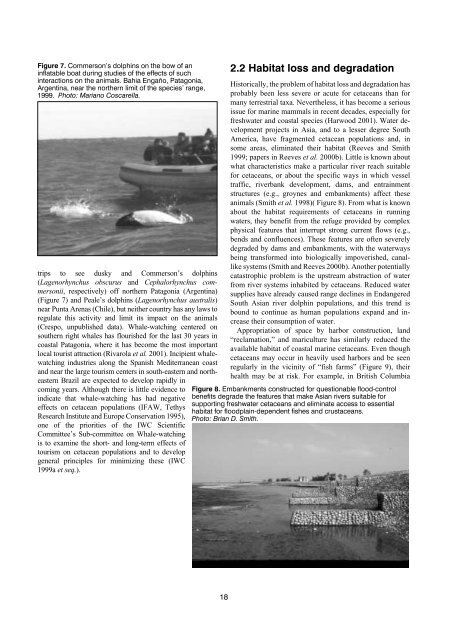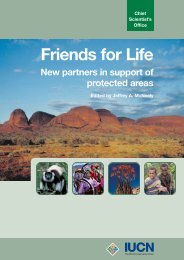Dolphins, Whales and Porpoises: 2002-2010 Conservation - IUCN
Dolphins, Whales and Porpoises: 2002-2010 Conservation - IUCN
Dolphins, Whales and Porpoises: 2002-2010 Conservation - IUCN
You also want an ePaper? Increase the reach of your titles
YUMPU automatically turns print PDFs into web optimized ePapers that Google loves.
Figure 7. Commerson’s dolphins on the bow of an<br />
inflatable boat during studies of the effects of such<br />
interactions on the animals. Bahia Engaño, Patagonia,<br />
Argentina, near the northern limit of the species’ range,<br />
1999. Photo: Mariano Coscarella.<br />
trips to see dusky <strong>and</strong> Commerson’s dolphins<br />
(Lagenorhynchus obscurus <strong>and</strong> Cephalorhynchus commersonii,<br />
respectively) off northern Patagonia (Argentina)<br />
(Figure 7) <strong>and</strong> Peale’s dolphins (Lagenorhynchus australis)<br />
near Punta Arenas (Chile), but neither country has any laws to<br />
regulate this activity <strong>and</strong> limit its impact on the animals<br />
(Crespo, unpublished data). Whale-watching centered on<br />
southern right whales has flourished for the last 30 years in<br />
coastal Patagonia, where it has become the most important<br />
local tourist attraction (Rivarola et al. 2001). Incipient whalewatching<br />
industries along the Spanish Mediterranean coast<br />
<strong>and</strong> near the large tourism centers in south-eastern <strong>and</strong> north-<br />
eastern Brazil are expected to develop rapidly in<br />
coming years. Although there is little evidence to<br />
indicate that whale-watching has had negative<br />
effects on cetacean populations (IFAW, Tethys<br />
Research Institute <strong>and</strong> Europe <strong>Conservation</strong> 1995),<br />
one of the priorities of the IWC Scientific<br />
Committee’s Sub-committee on Whale-watching<br />
is to examine the short- <strong>and</strong> long-term effects of<br />
tourism on cetacean populations <strong>and</strong> to develop<br />
general principles for minimizing these (IWC<br />
1999a et seq.).<br />
18<br />
2.2 Habitat loss <strong>and</strong> degradation<br />
Historically, the problem of habitat loss <strong>and</strong> degradation has<br />
probably been less severe or acute for cetaceans than for<br />
many terrestrial taxa. Nevertheless, it has become a serious<br />
issue for marine mammals in recent decades, especially for<br />
freshwater <strong>and</strong> coastal species (Harwood 2001). Water development<br />
projects in Asia, <strong>and</strong> to a lesser degree South<br />
America, have fragmented cetacean populations <strong>and</strong>, in<br />
some areas, eliminated their habitat (Reeves <strong>and</strong> Smith<br />
1999; papers in Reeves et al. 2000b). Little is known about<br />
what characteristics make a particular river reach suitable<br />
for cetaceans, or about the specific ways in which vessel<br />
traffic, riverbank development, dams, <strong>and</strong> entrainment<br />
structures (e.g., groynes <strong>and</strong> embankments) affect these<br />
animals (Smith et al. 1998)( Figure 8). From what is known<br />
about the habitat requirements of cetaceans in running<br />
waters, they benefit from the refuge provided by complex<br />
physical features that interrupt strong current flows (e.g.,<br />
bends <strong>and</strong> confluences). These features are often severely<br />
degraded by dams <strong>and</strong> embankments, with the waterways<br />
being transformed into biologically impoverished, canallike<br />
systems (Smith <strong>and</strong> Reeves 2000b). Another potentially<br />
catastrophic problem is the upstream abstraction of water<br />
from river systems inhabited by cetaceans. Reduced water<br />
supplies have already caused range declines in Endangered<br />
South Asian river dolphin populations, <strong>and</strong> this trend is<br />
bound to continue as human populations exp<strong>and</strong> <strong>and</strong> increase<br />
their consumption of water.<br />
Appropriation of space by harbor construction, l<strong>and</strong><br />
“reclamation,” <strong>and</strong> mariculture has similarly reduced the<br />
available habitat of coastal marine cetaceans. Even though<br />
cetaceans may occur in heavily used harbors <strong>and</strong> be seen<br />
regularly in the vicinity of “fish farms” (Figure 9), their<br />
health may be at risk. For example, in British Columbia<br />
Figure 8. Embankments constructed for questionable flood-control<br />
benefits degrade the features that make Asian rivers suitable for<br />
supporting freshwater cetaceans <strong>and</strong> eliminate access to essential<br />
habitat for floodplain-dependent fishes <strong>and</strong> crustaceans.<br />
Photo: Brian D. Smith.






